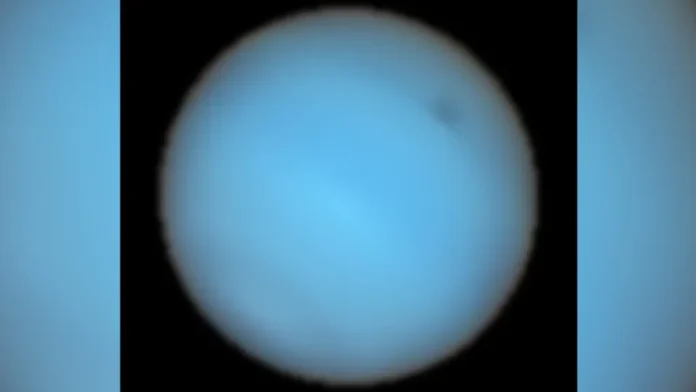Exploring Neptune’s Mysterious Dark Spot and its Enigmatic Companion
Neptune, the eighth and farthest planet in our solar system, continues to captivate astronomers with its enigmatic features. Recently, a significant discovery has taken place that sheds new light on the planet’s atmospheric phenomena. A large and mysterious dark spot has been spotted within Neptune’s atmosphere, and intriguingly, it is accompanied by an unexpectedly bright companion. This groundbreaking observation was made using the European Southern Observatory’s Very Large Telescope located in Chile. While space-based observatories like the Hubble Space Telescope have previously captured vortex-like storms resembling dark spots within Neptune’s atmosphere, this marks the first instance of such a phenomenon being observed through an Earth-based telescope.
Unveiling the Phenomenon: New Insights and Revelations
The fresh insights into Neptune’s atmospheric dynamics come courtesy of recent research published in the esteemed journal Nature Astronomy. The lead study author, Patrick Irwin, a distinguished professor of planetary physics at the University of Oxford, expresses his long-held curiosity about these transient and elusive dark features. The research delves into the nature and origins of these mysterious dark spots, unraveling a captivating tale of gas giants and celestial storms.
Gas Giants and the Intriguing Dark Spots
Giant gaseous planets, Neptune included, are renowned for the distinctive dark spots that manifest within their atmospheres. These spots are akin to Jupiter’s iconic Great Red Spot, a tempest that has raged for centuries. However, the recent observations on Neptune have sparked renewed interest in the phenomenon. The planet, known as an ice giant, has experienced a series of storms that have been observed by the Hubble Space Telescope over the years. These storms exhibit a pattern of emergence and dissipation over a span of approximately two years, making their study challenging.
The intriguing history of Neptune’s storms includes a glimpse from NASA’s Voyager 2 probe, launched in the 1970s. During its 1989 flyby of Neptune, Voyager 2 managed to capture images of two dark storms on the planet. Regrettably, these storms vanished before Hubble could observe them in 1994. The most notable storm, referred to as the Great Dark Spot, observed by Voyager 2, was so immense that it could engulf our own planet Earth.
A Different Kind of Storm: Understanding Neptune’s Atmosphere
Neptune’s storms exhibit behavior distinct from the hurricanes we are familiar with on Earth. These dark spots are high-pressure systems that exhibit stable rotation in a clockwise direction, a contrast to Earth’s Northern Hemisphere hurricanes that rotate counterclockwise. The critical question that the researchers, led by Patrick Irwin, aimed to address was the formation mechanism behind these colossal storms on Neptune.
Unveiling a Novel Neptune Feature: The Bright Companion
Neptune, with its characteristic blue hue due to the presence of methane in its atmosphere, is a frigid world with an average temperature of minus 392 degrees Fahrenheit (minus 235 degrees Celsius). The planet is subjected to fierce winds that propel frozen methane clouds at astonishing speeds of up to 1,200 miles per hour (1,931 kilometers per hour). Its immense distance from the sun, approximately 30 times farther than Earth, results in a unique visual experience: noon on Neptune resembles twilight on Earth.

In 2018, the discovery of new dark spots on Neptune prompted Irwin’s team to seize an opportunity for Earth-based observations. Utilizing the Very Large Telescope and its Multi Unit Spectroscopic Explorer instrument (MUSE), astronomers embarked on a journey to understand the underlying mechanisms of these atmospheric features. MUSE, boasting adaptive optics technology, compensates for atmospheric distortion, enabling the capture of sharp and detailed images of celestial objects.
Unraveling the Enigma: Dark Spots and Atmospheric Dynamics
The data gathered by the Very Large Telescope unveiled a surprising revelation regarding the nature of the dark spots. Contrary to previous assumptions, these spots do not arise from gaps or clearings within the clouds. Rather, observations suggest that the dark spots materialize as air particles darken and congregate beneath Neptune’s prominent atmospheric layer, mingling haze and ice in a mesmerizing dance of forces.
An exciting twist emerged as MUSE captured a three-dimensional spectrum of light for Neptune and its dark spot. This enabled astronomers to delve into the storm’s intricacies, leading to the unexpected discovery of a previously unidentified cloud type. This unique cloud manifested as a smaller, bright companion situated adjacent to the larger dark spot. The newfound features reside on the same atmospheric level, captivating astronomers with the prospect of uncharted revelations.
A New Era of Observational Capabilities
Michael Wong, a planetary scientist at the University of California, Berkeley, and coauthor of the study, lauds the groundbreaking advancement in humanity’s cosmic observations. He emphasizes the evolution from sending spacecraft for direct detection to remote observations with instruments like Hubble, culminating in the current milestone of ground-based detection with advanced technology. This progression has opened new doors to understanding celestial phenomena, enhancing our grasp of distant worlds.
In conclusion, Neptune’s enigmatic dark spots, long a subject of fascination, are yielding their secrets to meticulous observations and cutting-edge technology. The discovery of a bright companion to the dark spot marks a significant stride in unraveling the complexities of this distant ice giant. As research continues and technology advances, we are poised to gain even deeper insights into the intricate dynamics of Neptune’s atmosphere and the mysteries it holds.








[…] Exploring Neptune’s Mysterious Dark Spot and its Enigmatic Companion […]